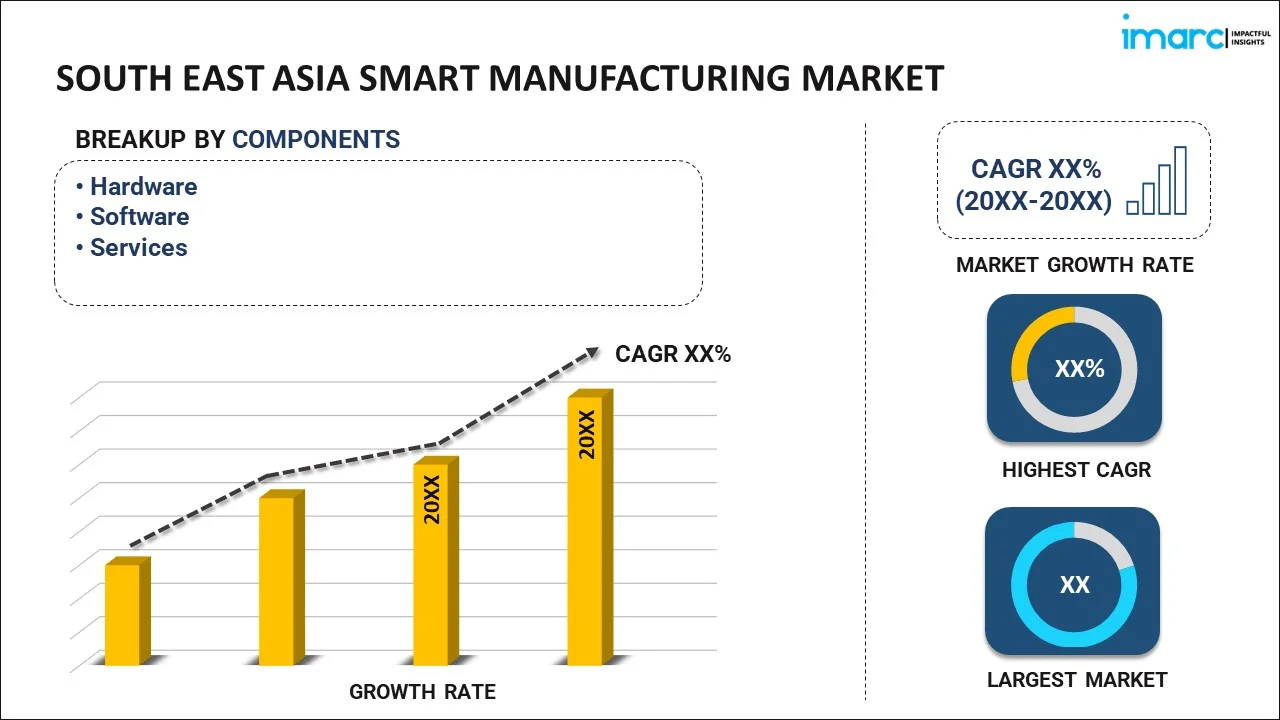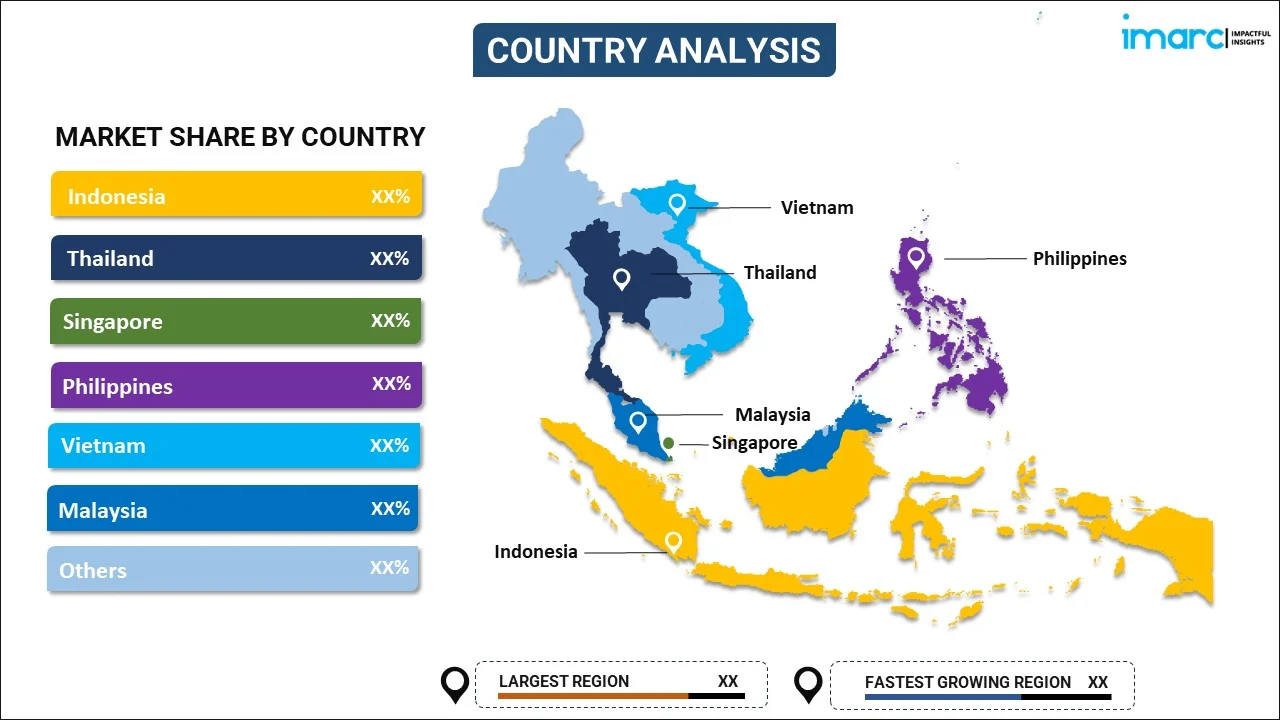
South East Asia Smart Manufacturing Market Report by Component (Hardware, Software, Services), Technology (Machine Execution Systems, Programmable Logic Controller, Enterprise Resource Planning, SCADA, Discrete Control Systems, Human Machine Interface, Machine Vision, 3D Printing, Product Lifecycle Management, Plant Asset Management), End Use (Automotive, Aerospace and Defense, Chemicals and Materials, Healthcare, Industrial Equipment, Electronics, Food and Agriculture, Oil and Gas, and Others), and Country 2024-2032
Market Overview:
South East Asia smart manufacturing market size is projected to exhibit a growth rate (CAGR) of 8.38% during 2024-2032. The growing integration of the Internet of Things (IoT) into manufacturing processes to supporting real-time monitoring, rising automation of various business and manufacturing processes, and increasing adoption of cybersecurity measures and the development of secure-by-design principles represent some of the key factors driving the market.
|
Report Attribute
|
Key Statistics
|
|---|---|
|
Base Year
|
2023 |
|
Forecast Years
|
2024-2032 |
|
Historical Years
|
2018-2023
|
| Market Growth Rate (2024-2032) | 8.38% |
Smart manufacturing integrates advanced technologies, such as the internet of things (IoT), artificial intelligence (AI), data analytics, and automation into the production process. It comprises a digital twin, which is a virtual replica of a physical item or process, used for analyzing and optimization. It also consists of industrial IoT (IIoT), which assists in real-time monitoring and controlling various industrial operations. It also encompasses additive manufacturing, wherein various products are built layer by layer, offering design flexibility. It enables real-time data-driven decision-making, process optimization, and improved responsiveness as per the requirements of customers. It allows businesses to achieve a competitive edge through improved efficiency and flexibility. It also offers predictive maintenance and energy efficiency measures to reduce operational costs. Smart manufacturing fosters innovation by creating new product designs and business models. It gathers vast amounts of data from sensors and equipment, providing valuable insights into production processes. It also assists manufacturers in predicting when equipment will require maintenance, thereby reducing downtime and costs.
South East Asia Smart Manufacturing Market Trends:
At present, the increasing integration of the Internet of Things (IoT) into manufacturing processes to conduct real-time monitoring, data collection, and analysis, facilitating predictive maintenance and process optimization, represents one of the crucial factors impelling the growth of the market in South East Asia. Collaborative robots, or cobots, are also becoming more prevalent, working alongside human workers to streamline tasks and improve safety. Besides this, the rising automation of various business and manufacturing processes to reduce the involvement of manual labor and maintain the safety of workers is contributing to the market growth in the region. In addition, the growing connectivity in smart manufacturing is becoming a critical concern for cybersecurity. Protecting sensitive data and manufacturing processes from cyber threats is leading to the development of robust security solutions. The adoption of cybersecurity measures and the development of secure-by-design principles are also essential to safeguard smart manufacturing environments from potential threats. Apart from this, high-speed, low-latency connectivity provided by 5G networks is facilitating seamless communication between devices and enables the widespread deployment of IIoT solutions. Manufacturers are leveraging real-time data analytics and remote monitoring, paving the way for more agile and flexible production processes. Additionally, the increasing emphasis on eco-friendly practices is encouraging manufacturers to incorporate smart technologies to reduce energy consumption, minimize waste, and optimize resource utilization. Smart manufacturing expedites the implementation of sustainable practices, aligning with global initiatives to address climate change and promote responsible industrial operations.
South East Asia Smart Manufacturing Market Segmentation:
IMARC Group provides an analysis of the key trends in each segment of the market, along with forecasts at the regional and country level for 2024-2032. Our report has categorized the market based on component, technology, and end use.
Component Insights:

- Hardware
- Software
- Services
The report has provided a detailed breakup and analysis of the market based on the component. This includes hardware, software, and services.
Technology Insights:
- Machine Execution Systems
- Programmable Logic Controller
- Enterprise Resource Planning
- SCADA
- Discrete Control Systems
- Human Machine Interface
- Machine Vision
- 3D Printing
- Product Lifecycle Management
- Plant Asset Management
A detailed breakup and analysis of the market based on the technology have also been provided in the report. This includes machine execution systems, programmable logic controller, enterprise resource planning, SCADA, discrete control systems, human machine interface, machine vision, 3D printing, product lifecycle management, and plant asset management.
End Use Insights:
- Automotive
- Aerospace and Defense
- Chemicals and Materials
- Healthcare
- Industrial Equipment
- Electronics
- Food and Agriculture
- Oil and Gas
- Others
The report has provided a detailed breakup and analysis of the market based on the end use. This includes automotive, aerospace and defense, chemicals and materials, healthcare, industrial equipment, electronics, food and agriculture, oil and gas, and others.
Country Insights:

- Indonesia
- Thailand
- Singapore
- Philippines
- Vietnam
- Malaysia
- Others
The report has also provided a comprehensive analysis of all the major regional markets, which include Indonesia, Thailand, Singapore, Philippines, Vietnam, Malaysia, and Others.
Competitive Landscape:
The market research report has also provided a comprehensive analysis of the competitive landscape in the market. Competitive analysis such as market structure, key player positioning, top winning strategies, competitive dashboard, and company evaluation quadrant has been covered in the report. Also, detailed profiles of all major companies have been provided
South East Asia Smart Manufacturing Market Report Coverage:
| Report Features | Details |
|---|---|
| Base Year of the Analysis | 2023 |
| Historical Period | 2018-2023 |
| Forecast Period | 2024-2032 |
| Units | US$ Million |
| Scope of the Report | Exploration of Historical Trends and Market Outlook, Industry Catalysts and Challenges, Segment-Wise Historical and Future Market Assessment:
|
| Components Covered | Hardware, Software, Services |
| Technologies Covered | Machine Execution Systems, Programmable Logic Controller, Enterprise Resource Planning, SCADA, Discrete Control Systems, Human Machine Interface, Machine Vision, 3D Printing, Product Lifecycle Management, Plant Asset Management |
| End Uses Covered | Automotive, Aerospace and Defense, Chemicals and Materials, Healthcare, Industrial Equipment, Electronics, Food and Agriculture, Oil and Gas, Others |
| Countries Covered | Indonesia, Thailand, Singapore, Philippines, Vietnam, Malaysia, Others |
| Customization Scope | 10% Free Customization |
| Report Price and Purchase Option | Single User License: US$ 3699 Five User License: US$ 4699 Corporate License: US$ 5699 |
| Post-Sale Analyst Support | 10-12 Weeks |
| Delivery Format | PDF and Excel through Email (We can also provide the editable version of the report in PPT/Word format on special request) |
Key Questions Answered in This Report:
- How has the South East Asia smart manufacturing market performed so far and how will it perform in the coming years?
- What has been the impact of COVID-19 on the South East Asia smart manufacturing market?
- What is the breakup of the South East Asia smart manufacturing market on the basis of component?
- What is the breakup of the South East Asia smart manufacturing market on the basis of technology?
- What is the breakup of the South East Asia smart manufacturing market on the basis of end use?
- What are the various stages in the value chain of the South East Asia smart manufacturing market?
- What are the key driving factors and challenges in South East Asia smart manufacturing?
- What is the structure of the South East Asia smart manufacturing market and who are the key players?
- What is the degree of competition in the South East Asia smart manufacturing market?
Key Benefits for Stakeholders:
- IMARC’s industry report offers a comprehensive quantitative analysis of various market segments, historical and current market trends, market forecasts, and dynamics of the South East Asia smart manufacturing market from 2018-2032.
- This research report provides the latest information on the market drivers, challenges, and opportunities in the South East Asia smart manufacturing market.
- Porter's five forces analysis assist stakeholders in assessing the impact of new entrants, competitive rivalry, supplier power, buyer power, and the threat of substitution. It helps stakeholders to analyze the level of competition within the South East Asia smart manufacturing industry and its attractiveness.
- A competitive landscape allows stakeholders to understand their competitive environment and provides an insight into the current positions of key players in the market.
Need more help?
- Speak to our experienced analysts for insights on the current market scenarios.
- Include additional segments and countries to customize the report as per your requirement.
- Gain an unparalleled competitive advantage in your domain by understanding how to utilize the report and positively impacting your operations and revenue.
- For further assistance, please connect with our analysts.
 Inquire Before Buying
Inquire Before Buying
 Speak to an Analyst
Speak to an Analyst
 Request Brochure
Request Brochure
 Request Customization
Request Customization




.webp)




.webp)












